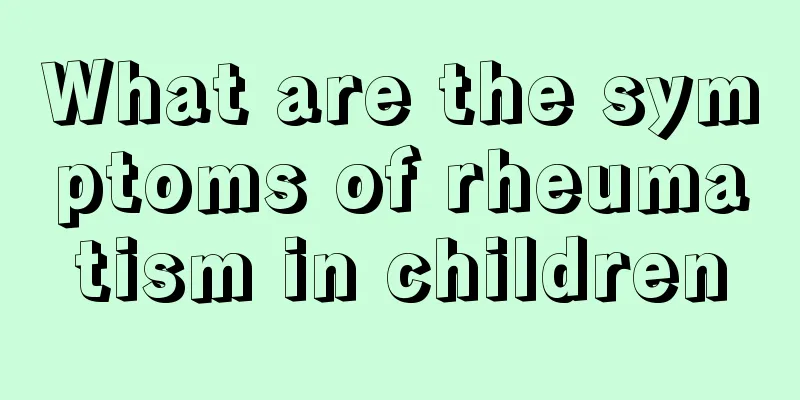What are the symptoms of rheumatism in children

|
We all know that rheumatism is a common disease among the elderly, but children may also suffer from rheumatism. If children live in a stuffy, dark and humid environment for a long time, they are likely to suffer from rheumatism. Especially children with malnutrition and weak resistance are more likely to contract the disease in a humid environment. Rheumatism in children can affect their development, causing them to become less mobile and, in severe cases, develop joint deformities. Parents must pay attention to this. Therefore, when children have joint pain, redness and swelling, they must seek medical attention as soon as possible, otherwise it will be difficult to cure the disease. The most common symptoms of rheumatic diseases: 1. Pain is the main symptom of rheumatism, which can manifest as local pain, body pain, joint pain and muscle pain. The onset of pain can be acute or slow, and the degree of pain can be severe or mild, or it may only manifest as discomfort, soreness, or numbness. Pain is often caused by cold or wind, which triggers or aggravates the original symptoms; joint swelling and pain not caused by trauma are often manifestations of rheumatism. Joint pain, neck and shoulder pain, low back pain, and heel pain are often common manifestations of rheumatism, sometimes accompanied by swollen joints and stiffness in the morning. Rheumatoid arthritis often has symmetrical joint swelling and pain, which is particularly obvious in the proximal interphalangeal joints, metacarpophalangeal joints, and wrist joints; ankylosing spondylitis has low back pain, which is more severe at night, in the morning, and when resting, and improves after a little activity, and may be accompanied by heel pain and uveitis; joint pain caused by gout often occurs at night, with severe knife-like pain, which peaks within 24 hours and is most common in the joints of the feet. A single joint is affected, accompanied by local swelling and redness; muscle weakness accompanied by muscle pain and elevated muscle enzymes are common in polymyositis/dermatomyositis, systemic lupus erythematosus, etc. 2. Fever is a common symptom of rheumatism, which can be low fever, moderate fever, or high fever. It is often manifested as irregular fever and rapid erythrocyte sedimentation rate, but generally no chills. Antibiotic treatment is ineffective, but hormone treatment is effective. For example, systemic lupus erythematosus, adult-onset Still's disease, and panniculitis may all present with fever as the first symptom. In order to prevent children from suffering from rheumatism, parents must be careful not to let their children sleep on the floor or use air conditioning often. The consequences of seeking coolness in the summer are very uncomfortable, and children are prone to catching colds and fevers. When children cry, have joint pain, fever, rash, etc., parents should pay attention and seek medical treatment in time. To prevent rheumatism in children, we must first maintain indoor hygiene and air circulation, strengthen children's physical fitness, exercise more, and avoid catching cold. |
<<: What are the symptoms of rheumatoid arthritis in children?
>>: What to eat for children with high blood pressure
Recommend
How to teach children to make friends?
Interaction between people is very important. A p...
How to correct crossed eyes in babies?
If the baby already has strabismus, parents can o...
What to do if the newborn's hands and feet are cold
Parents who have taken care of children know that...
Effects of herpes labialis on babies
We all know that during pregnancy, women's fa...
How to solve the problem of baby crying after pooping
Why does the baby cry before pooping? This is a v...
How to treat yellowing on children's underwear
Underwear is the clothing that is closest to our ...
What should children drink to grow taller
Although we all know that how tall a person can g...
What are the symptoms of neonatal encephalopathy during recovery?
Generally speaking, the symptoms of neonatal ence...
Reasons for peeling skin on baby's face
It is the wish of many parents that every baby ca...
Your child's eyes are red and secrete a lot. Do you know why?
Parents should pay attention. If you find that yo...
Treatment of viral myocarditis in children: these measures must be understood
If viral myocarditis occurs in a child, parents m...
What to do if your baby has a fever and low white blood cell count
Young parents will definitely be anxious when the...
How to guide children to read?
Reading is of great help to children, so it is ve...
What is the baby's development standard at five months of pregnancy?
What are the development standards for a baby at ...
Can children wear plasters?
The plasters that are more common in our lives us...









